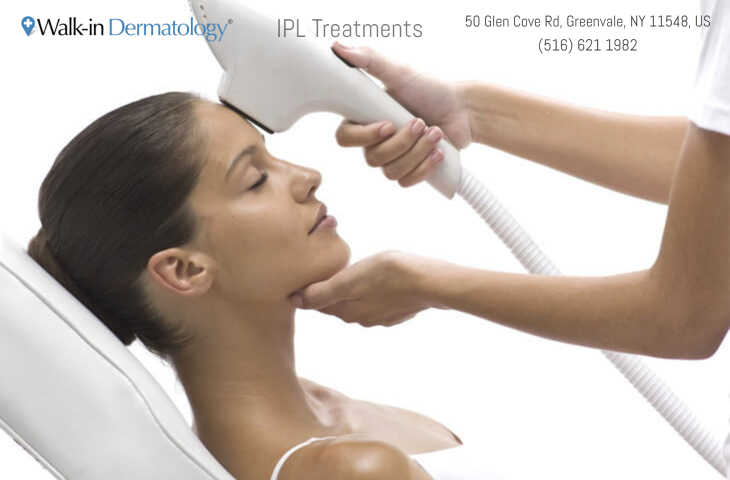Tues: 8:30am - 3:00pm
Wed: 12:00pm - 6:00pm
Thurs: 8:30am - 3:00pm
Fri: Closed
Sat: 8:30am - 12:30pm
Sun: Closed
Greenvale, NY 11548
What Are the Benefits of IPL Treatments?


Photofacials, also sometimes referred to as IPL therapy, are among the most popular options for non-invasive, anti-aging treatments. IPL stands for Intense Pulsed Light, a technology that uses short pulses of broad-spectrum laser light directed over the skin’s surface. Developed in the 1990s, IPL is proven to roll back the visible signs of aging skin by dissolving damaged or discolored skin cells and boosting collagen production. Collagen is a protein that creates connective tissue and gives skin a firm, healthy appearance.
If you want to stop the clock on aging skin, IPL therapy may be the right solution for you.
A 10-year study by Stanford University shows IPL therapy not only repairs signs of aging, but helps to prevent future signs as well. With 2 to 3 IPL treatments per year research participants saw a transformation in their skin to resemble much younger looking skin. Some showed smoother and more even-toned skin at the end of the study than they had 10 years earlier when they started IPL treatments.
Among the benefits of IPL therapy, sessions last only 30 to 90 minutes, depending on the skin area being treated. Downtime is minimal.
Dermatologists often recommend IPL treatment to reduce pigmentation because the therapy targets the melanin present in your skin. This is what causes pigmentation and discoloration, often caused by prolonged sun exposure. Your 2 to 3 initial IPL treatments can make a significant improvement in the appearance of dark spots. IPL therapy also has the advantage of covering a large skin area and there is very little post-procedure downtime.
IPL treatments can be used on the face, neck, chest, as well as arms and hands.
Therapy typically involves an initial set of 2 to 3 treatments spaced about a month apart, followed by 2 to 3 annual maintenance treatments.
The immediate result of initial IPL therapy is a decrease in skin discoloration. Maintenance treatments help to keep your skin looking younger and healthy, promote collagen growth, prevent the effects of sun damage, and give the skin a healthy glow.
Another benefit of IPL therapy is that it can be used in combination with other facial skin procedures, such as chemical peels and microdermabrasion. These treatments target the surface layer of skin, while IPL reaches the deeper layers of skin.
IPL was among the first photo-rejuvenation technologies.
Today IPL is used to treat:
- Rosacea (redness and visible blood vessels in the face)
- Scarring
- Enlarged pores (IPL can help eliminate large pores and reduce the appearance of skin acne without the need for topical products that dry out skin)
- Acne and acne scars
- Birthmarks
- Redness
- Broken capillaries (also known as spider veins due to the web-like appearance)
- Dyschromia (discoloration of the skin or nails)
- Melasma (brown or gray patches, usually appearing on the face)
- Brown spots
- Freckles
- Sunspots
- Age spots
- Hyperpigmentation (darker skin patches caused by an excess of melanin, the brown pigment that produces normal skin color)
- Vascular and pigmented lesions
- Uneven skin tone and texture
- Fine lines and wrinkles
How Does IPL Work?
A handheld device is passed over your skin, sending pulses of broad spectrum light into the deep layers of the skin. Because this pulsing light reaches the skin on a molecular level, there are no incisions or injections. The range of light waves in an IPL treatment target melanin and hemoglobin in the skin, releasing these hyperpigmentation spots, blemishes and blotches. IPL light waves also gently heat the deeper layers of skin. This stimulates collagen production, which reduces the appearance of fine lines, scars and wrinkles. Unlike lasers, IPL produces more than one wavelength of pulsating light. As a result, IPL can treat a range of skin conditions at the same time.
What Happens After an IPL Treatment?
- Freckles and age spots may appear darker for 3 to 7 days after treatment. This is normal.
- Crusting may appear on the treated skin. This is also normal and should go away within a week to 10 days.
- In rare instances, patients may experience bruising, which typically fades in about a week.
Down time after light-therapy treatment is usually minimal, but there are precautions to take. Your skin will be sensitive and may feel like it has been sunburned.
Until that sensation goes away, you should avoid:
- Showering, swimming, hot tubbing, saunas or vigorous exercise for at least 24 hours.
- Applying makeup over the treated areas. You can start using makeup a day or two after the treatment as long as the area does not feel sunburned. Apply and remove makeup gently from the skin treated with IPL.
- Using scented soaps or lotions, deodorants, and active skin care ingredients that contain retinol and glycolic acids.
- Sun exposure and tanning beds
Your dermatologist may recommend a specially formulated recovery cream for you to apply to your skin after treatment.
As with any technologically advanced therapy, the skill of the IPL dermatologist is just as important as the equipment for you to receive the best results. This is why you should review the credentials and experience of any dermatologist you are considering for any cosmetic procedure. Professionals use medical-grade equipment, which cannot be operated by amateurs. Another factor to consider is price. If you find an unusually inexpensive deal on IPL therapy, most likely corners are being cut somewhere, either in the skill of the therapist or the quality of the equipment.
Getting the Best Results from Your IPL Therapy
Preparing and stimulating your skin before the IPL procedure can help your results. Follow this suggested skincare regimen for 7to 14 days prior to the IPL appointment:
Mornings
- Avoid wearing makeup, if possible
- Clean the skin area with a gentle cleanser
- Apply a moisturizer
- Apply sunblock lotion with a SPF 30 or higher
Evenings
- Clean the area gently
- Apply a moisturizer
What to Avoid Before your IPL Therapy Appointment
- Tanning in the sun, a tanning bed, using tanning creams for 4 weeks
- No waxing, chemical peels or collagen shots for 2 weeks
- Do not wear perfume, makeup, deodorant, or any skin irritants before the appointment
- Do not take aspirin or other drugs that cause blood thinning
What Conditions Would Prevent Someone from Receiving IPL Treatment?
Talk to your dermatologist if you:
- Are pregnant
- Have a skin condition
- Take medication for other conditions
You Should Not Take IPL Therapy If You:
- Are sensitive to light
- Have recently tanned using sunlight, tanning beds, or tanning creams
- Might have skin cancer
- Use a retinoid cream
- Have very dark skin
Getting the Best Treatment
The good news is you don’t have to look far for excellent dermatology services – and now there’s no waiting.
In many parts of New York and throughout the country, patients often have to wait weeks before they can see a board-certified dermatologist.
That’s no longer necessary.
At Walk-in Dermatology, patients can see a board-certified dermatologist seven days a week. Our dermatologists will evaluate your skin and, if light therapy seems like the right solution, will work with you to determine whether IPL or BBL treatment is best for you.
No more waiting days or even weeks to receive light therapy treatments. If you are seeking a non-surgical way to revitalize your appearance and treat sun damage, wrinkles and fine lines, rosacea, enlarged pores, scars and more, Walk-in Dermatology is open and ready to serve you.
Read more: How Long Does IPL Take to Heal?








